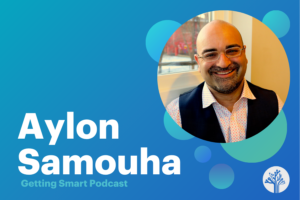League of Innovative Schools: A Network Creating the Future of Learning

Ninety-three of the most forward-leaning school districts in the country make up the League of Innovative Schools, the flagship network of district superintendents at Digital Promise. League members share a commitment to pioneering innovative learning strategies and collaborating with researchers to drive improvement.
Launched six years ago, the League was formed to bring researchers, entrepreneurs, and educators together to design and share new ideas and new tools.
Membership in the League is based on a combination of superintendent and school district qualifications. The League charter emphasizes engagement and collaboration.
League members come from 33 states and serve more than 3.3 million students. They represent the range of contexts and challenges in American education – from large urban centers to remote rural schools. Member districts range from 435 students to more than 200,000 students.
After five months on the job, Executive Director Kimberly Smith has a strategy for boosting League impact. Smith is a student of education innovation, having served in executive roles at NFTE, PBS and Discovery Education.
Having visited many of the League member districts, Smith sees lots of energy and opportunity for deeper collaboration, scaling the League’s impact, and expanding the League’s work in districts to more deeply engage principals and teachers.
Shared Challenges–For Districts and Students
There is a clear opportunity to build on the work of League members, said Smith, by evolving to a collaborative action network model where districts surface common challenges and partner with researchers and developers to solve the challenges.
Smith sees members as empowered solution creators working together in “Challenge Collaboratives,” which she defines as agile R&D for building programs, tools, and models. For example, a group of districts could work to create a framework for computational thinking or develop a tool for evaluating resources to support English language learners. There is also the potential for multiple districts to work together on a shared data interoperability solution (42 League district leaders are currently participating in a Dell Foundation-supported initiative to scale interoperability).
In addition to convening key practitioners and thought leaders, Smith sees the League contributing to the education innovation landscape through the development of toolkits, such as the competency-based education playbook produced in collaboration with League districts including Kettle Moraine School District in Wisconsin.
To showcase each district, the League will develop a comprehensive portfolio of district-specific innovations with associated research and stories of innovation-in-action. Smith said they will showcase the work in engaging ways that make it easy for districts across the country to implement the promising innovations.
While its impact will grow, the core of the League is likely to remain around 100 member districts to preserve the intimate and collaborative nature of its convenings and work.
Many League members attended the Fusion conference in November, allowing district leaders to connect both within and beyond the League. Members engaged with each other to further their thinking on their respective implementations of personalized learning.
Smith plans to scale the opportunities for collaboration by building stronger links between the League and another Digital Promise initiative, Education Innovation Clusters. These two dozen regional communities of practice bring together educators, researchers, entrepreneurs, funders, local non-profits, and other community organizations to support innovative teaching and learning in their region.
Some regions with multiple League members already operate as an education innovation cluster. For example, there are six League district members in metro Pittsburgh that all collaborate through the #RemakeLearning network (see features on Montour and South Fayette Schools).

In San Diego, there is a cluster focused on workforce development. In Rhode Island, EduvateRI focuses on personalized learning. In New Orleans, 4.0 Schools leads a focus on next-generation school models. The clusters are often less formal organizations than the League districts, making it possible for districts to benefit from regional activities and working groups.
Together, the League and the Education Innovation Clusters team will play a convening role for networks of networks. They will look for opportunities to develop network effects in regions and around work streams. (Network effect means bigger is better–the value derived from participating increases with scale). Some social network analysis over the next six months will help identify how League and Clusters members engage with each other and opportunities for both deepening and scaling collaborations, outputs, and outcomes for students.
In another collaboration effort, many League members attended the Fusion conference in November, allowing district leaders to connect both within and beyond the League. Members engaged with each other to further their thinking on their respective implementations of personalized learning.
Personalized learning offers great opportunity to better prepare more young people but it remains difficult to execute with few proven models and inadequate tools. Networks like the League of Innovative Schools and Education Innovation Clusters provide a space for enabling school districts to share, learn, and create the future of learning.
For more, see:
- Chan Zuckerberg Backs Personalized Learning R&D Agenda (a report from Digital Promise Fusion Conference)
- Smart List: 30 School Districts Worth Visiting
- How School Networks Work And Why That’s Important
Stay in-the-know with all things EdTech and innovations in learning by signing up to receive the weekly Smart Update. This post includes mentions of a Getting Smart partner. For a full list of partners, affiliate organizations and all other disclosures, please see our Partner page.






0 Comments
Leave a Comment
Your email address will not be published. All fields are required.